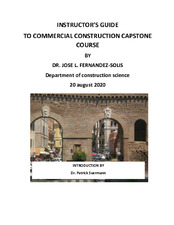| dc.description.abstract | The American Council for Construction Education (ACCE) is the accrediting institution for most colleges and universities’ construction programs in the United States of America (USA). The ACCE standards committee has an ongoing discussion on how to assess student teamwork within a project’s context. The Instructor’s Guide to Commercial Construction Capstone Course provides the pedagogy along with a system for team evaluation that is now tested using Project Based Learning (PBL - Worcester Polytechnic Institute), and Active Learning (AL - TAMU Center for Teaching Excellence) in a Construction Science (COSC) commercial capstone senior class. This approach received the Presidential Transformational Learning grant of $60k, plus, a $15K Construction Science Department grant, resulting in this open access instructor’s guide.
The Instructor’s Guide provides the journey that led to the current teaching practice. This journey is aided by discoveries in learning and instructional technique improvements. Richard F. Vaz, Professor, Interdisciplinary and Global Studies Co-Director, Center for PBL - Worcester Polytechnic Institute provided a foundation to move into PBL at a deeper level than simply having a class project. Likewise, Active Learning is different than what the words imply at face value. Another principle that is easily misunderstood but has a wealth of knowledge and pedagogical wisdom is Susan Wolcott’s Steps for Better Thinking, the basis for one of the 20 ACCE Student Learning Outcome (SLO) that is required by the ACCE for accreditation.
This three-legged approach of project based, active learning and SLO’s are combined with a team approach evaluated by team peers directly involved with one another. Again, this is easier said than done. Most faculties have found that the teams quickly evolve in a community of excellence where everyone is a star deserving 100, thus, foiling any serious attempt at discerning levels of performance. The proposed and tested program creates differing teams throughout the semester with leaders and members along with regularly assessing peer-presentations and peer-team performance. The process cannot impede those that give 100 to everyone, but the number of ‘all 100’s evaluation for teammates’ is now approximately 1% of the class participants. Hence, the proposed method of instruction with its unique set up and pedagogy creates a true project based, active learning, SLO-based team peer-evaluation that can be institutionalized and tested. This Instructor Guide to Commercial Construction Capstone Course should be implemented as a whole recognizing that it will be a starting point for a faculty member’s continued learning on how to improve a solid teaching method. | en |


